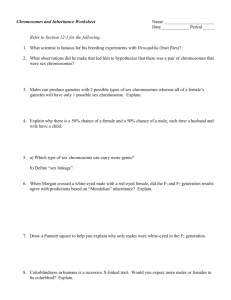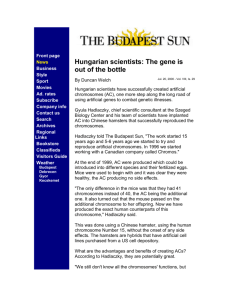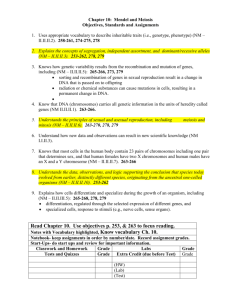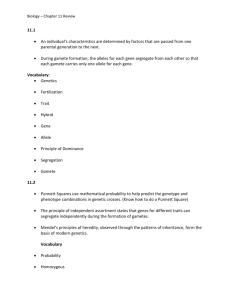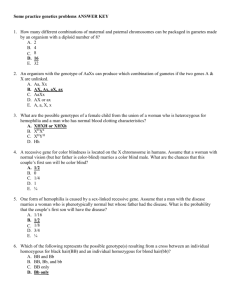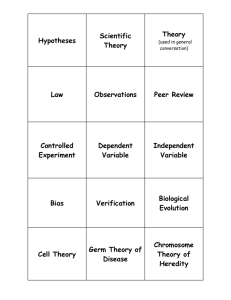Chromosomal Basis
advertisement
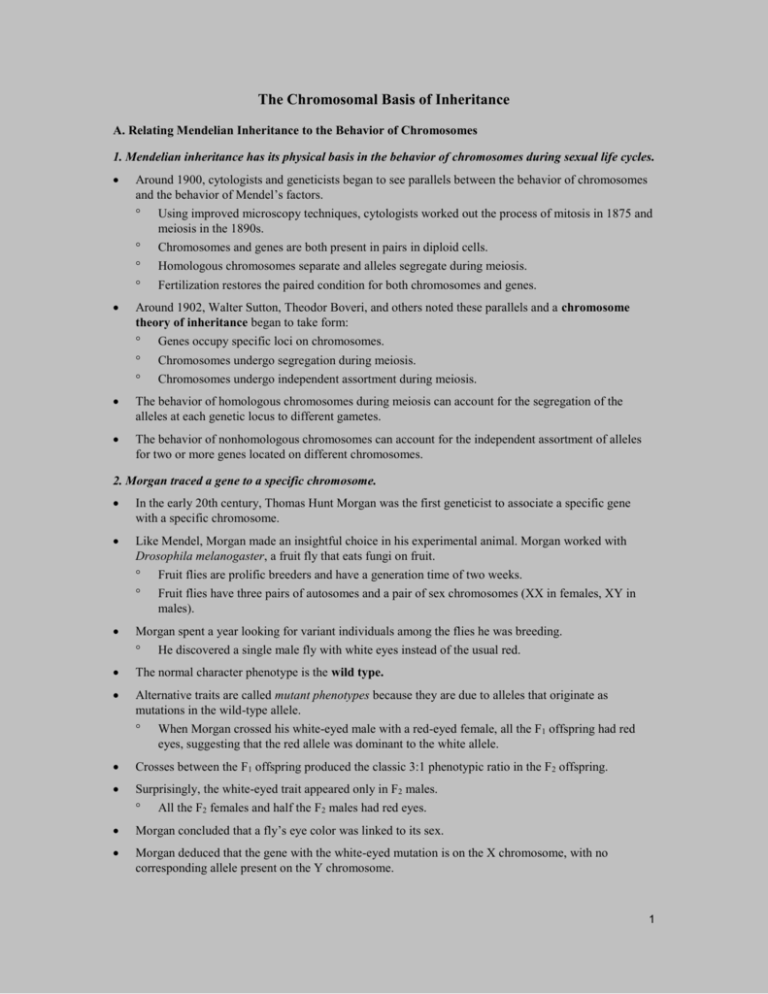
The Chromosomal Basis of Inheritance A. Relating Mendelian Inheritance to the Behavior of Chromosomes 1. Mendelian inheritance has its physical basis in the behavior of chromosomes during sexual life cycles. Around 1900, cytologists and geneticists began to see parallels between the behavior of chromosomes and the behavior of Mendel’s factors. Using improved microscopy techniques, cytologists worked out the process of mitosis in 1875 and meiosis in the 1890s. Chromosomes and genes are both present in pairs in diploid cells. Homologous chromosomes separate and alleles segregate during meiosis. Fertilization restores the paired condition for both chromosomes and genes. Around 1902, Walter Sutton, Theodor Boveri, and others noted these parallels and a chromosome theory of inheritance began to take form: Genes occupy specific loci on chromosomes. Chromosomes undergo segregation during meiosis. Chromosomes undergo independent assortment during meiosis. The behavior of homologous chromosomes during meiosis can account for the segregation of the alleles at each genetic locus to different gametes. The behavior of nonhomologous chromosomes can account for the independent assortment of alleles for two or more genes located on different chromosomes. 2. Morgan traced a gene to a specific chromosome. In the early 20th century, Thomas Hunt Morgan was the first geneticist to associate a specific gene with a specific chromosome. Like Mendel, Morgan made an insightful choice in his experimental animal. Morgan worked with Drosophila melanogaster, a fruit fly that eats fungi on fruit. Fruit flies are prolific breeders and have a generation time of two weeks. Fruit flies have three pairs of autosomes and a pair of sex chromosomes (XX in females, XY in males). Morgan spent a year looking for variant individuals among the flies he was breeding. He discovered a single male fly with white eyes instead of the usual red. The normal character phenotype is the wild type. Alternative traits are called mutant phenotypes because they are due to alleles that originate as mutations in the wild-type allele. When Morgan crossed his white-eyed male with a red-eyed female, all the F1 offspring had red eyes, suggesting that the red allele was dominant to the white allele. Crosses between the F1 offspring produced the classic 3:1 phenotypic ratio in the F2 offspring. Surprisingly, the white-eyed trait appeared only in F2 males. All the F2 females and half the F2 males had red eyes. Morgan concluded that a fly’s eye color was linked to its sex. Morgan deduced that the gene with the white-eyed mutation is on the X chromosome, with no corresponding allele present on the Y chromosome. 1 Females (XX) may have two red-eyed alleles and have red eyes or may be heterozygous and have red eyes. Males (XY) have only a single allele. They will be red-eyed if they have a red-eyed allele or white-eyed if they have a white-eyed allele. 3. Linked genes tend to be inherited together because they are located on the same chromosome. Each chromosome has hundreds or thousands of genes. Genes located on the same chromosome that tend to be inherited together are called linked genes. Results of crosses with linked genes deviate from those expected according to independent assortment. Morgan observed this linkage and its deviations when he followed the inheritance of characters for body color and wing size. The wild-type body color is gray (b+), and the mutant is black (b). The wild-type wing size is normal (vg+), and the mutant has vestigial wings (vg). The mutant alleles are recessive to the wild-type alleles. Neither gene is on a sex chromosome. Morgan crossed F1 heterozygous females (b+bvg+vg) with homozygous recessive males (bbvgvg). According to independent assortment, this should produce 4 phenotypes in a 1:1:1:1 ratio. Surprisingly, Morgan observed a large number of wild-type (gray-normal) and double-mutant (blackvestigial) flies among the offspring. These phenotypes are those of the parents. Morgan reasoned that body color and wing shape are usually inherited together because the genes for these characters are on the same chromosome. The other two phenotypes (gray-vestigial and black-normal) were fewer than expected from independent assortment (but totally unexpected from dependent assortment). What led to this genetic recombination, the production of offspring with new combinations of traits? 4. Independent assortment of chromosomes and crossing over produce genetic recombinants. Genetic recombination can result from independent assortment of genes located on nonhomologous chromosomes or from crossing over of genes located on homologous chromosomes. Mendel’s dihybrid cross experiments produced offspring that had a combination of traits that did not match either parent in the P generation. If the P generation consists of a yellow-round seed parent (YYRR) crossed with a green-wrinkled seed parent (yyrr), all F1 plants have yellow-round seeds (YyRr). A cross between an F1 plant and a homozygous recessive plant (a testcross) produces four phenotypes. Half are the parental types, with phenotypes that match the original P parents, with either yellowround seeds or green-wrinkled seeds. Half are recombinants, new combinations of parental traits, with yellow-wrinkled or green-round seeds. A 50% frequency of recombination is observed for any two genes located on different (nonhomologous) chromosomes. The physical basis of recombination between unlinked genes is the random orientation of homologous chromosomes at metaphase I of meiosis, which leads to the independent assortment of alleles. The F1 parent (YyRr) produces gametes with four different combinations of alleles: YR, Yr, yR, and yr. 2 The orientation of the tetrad containing the seed-color gene has no bearing on the orientation of the tetrad with the seed-shape gene. In contrast, linked genes, genes located on the same chromosome, tend to move together through meiosis and fertilization. Under normal Mendelian genetic rules, we would not expect linked genes to recombine into assortments of alleles not found in the parents. If the seed color and seed coat genes were linked, we would expect the F1 offspring to produce only two types of gametes, YR and yr, when the tetrads separate. One homologous chromosome carries the Y and R alleles on the same chromosome, and the other homologous chromosome carries the y and r alleles. The results of Morgan’s testcross for body color and wing shape did not conform to either independent assortment or complete linkage. Under independent assortment, the testcross should produce a 1:1:1:1 phenotypic ratio. If completely linked, we should expect to see a 1:1:0:0 ratio with only parental phenotypes among offspring. Most of the offspring had parental phenotypes, suggesting linkage between the genes. However, 17% of the flies were recombinants, suggesting incomplete linkage. Morgan proposed that some mechanism must occasionally break the physical connection between genes on the same chromosome. This process, called crossing over, accounts for the recombination of linked genes. Crossing over occurs while replicated homologous chromosomes are paired during prophase of meiosis I. One maternal and one paternal chromatid break at corresponding points and then rejoin with each other. The occasional production of recombinant gametes during meiosis accounts for the occurrence of recombinant phenotypes in Morgan’s testcross. The percentage of recombinant offspring, the recombination frequency, is related to the distance between linked genes. 5. Geneticists can use recombination data to map a chromosome’s genetic loci. One of Morgan’s students, Alfred Sturtevant, used crossing over of linked genes to develop a method for constructing a genetic map, an ordered list of the genetic loci along a particular chromosome. Sturtevant hypothesized that the frequency of recombinant offspring reflected the distance between genes on a chromosome. He assumed that crossing over is a random event, and that the chance of crossing over is approximately equal at all points on a chromosome. Sturtevant predicted that the farther apart two genes are, the higher the probability that a crossover will occur between them, and therefore, the higher the recombination frequency. The greater the distance between two genes, the more points there are between them where crossing over can occur. Sturtevant used recombination frequencies from fruit fly crosses to map the relative position of genes along chromosomes. A genetic map based on recombination frequencies is called a linkage map. 3 Sturtevant used the testcross design to map the relative position of three fruit fly genes, body color (b), wing size (vg), and eye color (cn). The recombination frequency between cn and b is 9%. The recombination frequency between cn and vg is 9.5%. The recombination frequency between b and vg is 17%. The only possible arrangement of these three genes places the eye color gene between the other two. Sturtevant expressed the distance between genes, the recombination frequency, as map units. One map unit (called a centimorgan) is equivalent to a 1% recombination frequency. Some genes on a chromosome are so far apart that a crossover between them is virtually certain. In this case, the frequency of recombination reaches its maximum value of 50% and the genes behave as if found on separate chromosomes. In fact, two genes studied by Mendel—for seed color and flower color—are located on the same chromosome but still assort independently. Genes located far apart on a chromosome are mapped by adding the recombination frequencies between the distant genes and the intervening genes. Sturtevant and his colleagues were able to map the linear positions of genes in Drosophila into four groups, one for each chromosome. A linkage map provides an imperfect picture of a chromosome. Map units indicate relative distance and order, not precise locations of genes. The frequency of crossing over is not actually uniform over the length of a chromosome. A linkage map does portray the order of genes along a chromosome, but does not accurately portray the precise location of those genes. B. Sex Chromosomes 1. The chromosomal basis of sex. Although the anatomical and physiological differences between women and men are numerous, the chromosomal basis of sex is rather simple. In humans and other mammals, there are two varieties of sex chromosomes, X and Y. An individual who inherits two X chromosomes usually develops as a female. An individual who inherits an X and a Y chromosome usually develops as a male. In the X-Y system, the Y chromosome is much smaller than the X chromosome. Only relatively short segments at either end of the Y chromosome are homologous with the corresponding regions of the X chromosome. The X and Y rarely cross over. In both testes (XY) and ovaries (XX), the two sex chromosomes segregate during meiosis, and each gamete receives one. Each ovum receives an X chromosome. Half the sperm cells receive an X chromosome, and half receive a Y chromosome. Because of this, each conception has about a fifty-fifty chance of producing a particular sex. If a sperm cell bearing an X chromosome fertilizes an ovum, the resulting zygote is female (XX). If a sperm cell bearing a Y chromosome fertilizes an ovum, the resulting zygote is male (XY). 4 2. Sex-linked genes have unique patterns of inheritance. In addition to their role in determining sex, the sex chromosomes, especially the X chromosome, have genes for many characters unrelated to sex. A gene located on either sex chromosome is called a sex-linked gene. In humans, the term refers to a gene on the X chromosome. Human sex-linked genes follow the same pattern of inheritance as Morgan’s white-eye locus in Drosophila. Fathers pass sex-linked alleles to all their daughters but none of their sons. Mothers pass sex-linked alleles to both sons and daughters. If a sex-linked trait is due to a recessive allele, a female will express this phenotype only if she is homozygous. Heterozygous females are carriers for the recessive trait. Because males have only one X chromosome (hemizygous), any male receiving the recessive allele from his mother will express the recessive trait. The chance of a female inheriting a double dose of the mutant allele is much less than the chance of a male inheriting a single dose. Therefore, males are far more likely to exhibit sex-linked recessive disorders than are females. For example, color blindness is a mild disorder inherited as a sex-linked trait. A color-blind daughter may be born to a color-blind father whose mate is a carrier. However, the odds of this are fairly low. Several serious human disorders are sex-linked. Hemophilia is a sex-linked recessive disorder defined by the absence of one or more proteins required for blood clotting. These proteins normally slow and then stop bleeding. Individuals with hemophilia have prolonged bleeding because a firm clot forms slowly. Bleeding in muscles and joints can be painful and can lead to serious damage. Today, people with hemophilia can be treated with intravenous injections of the missing protein. C. Errors and Exceptions in Chromosomal Inheritance Physical and chemical disturbances can damage chromosomes in major ways. Errors during meiosis can alter chromosome number in a cell. Plants tolerate genetic defects to a greater extent that do animals. 1. Alterations of chromosome number cause some genetic disorders. Nondisjunction occurs when problems with the meiotic spindle cause errors in daughter cells. This may occur if tetrad chromosomes do not separate properly during meiosis I. Alternatively, sister chromatids may fail to separate during meiosis II. As a consequence of nondisjunction, one gamete receives two of the same type of chromosome, and another gamete receives no copy. Offspring resulting from fertilization of a normal gamete with one produced by nondisjunction will have an abnormal chromosome number, a condition known as aneuploidy. Trisomic cells have three copies of a particular chromosome type and have 2n + 1 total chromosomes. 5 Monosomic cells have only one copy of a particular chromosome type and have 2n − 1 chromosomes. If the organism survives, aneuploidy typically leads to a distinct phenotype. Aneuploidy can also occur during failures of the mitotic spindle. If this happens early in development, the aneuploid condition will be passed along by mitosis to a large number of cells. This is likely to have a substantial effect on the organism. Organisms with more than two complete sets of chromosomes are polyploid. This may occur when a normal gamete fertilizes another gamete in which there has been nondisjunction of all its chromosomes. The resulting zygote would be triploid (3n). Alternatively, if a 2n zygote failed to divide after replicating its chromosomes, a tetraploid (4n) embryo would result from subsequent successful cycles of mitosis. Polyploidy is relatively common among plants and much less common among animals, although it is known to occur in fishes and amphibians. The spontaneous origin of polyploid individuals plays an important role in the evolution of plants. Both fishes and amphibians have polyploid species. Recently, researchers in Chile have identified a new rodent species that may be tetraploid. Polyploids are more nearly normal in phenotype than aneuploids. One extra or missing chromosome apparently upsets the genetic balance during development more than does an entire extra set of chromosomes. 2. Alterations of chromosome structure cause some genetic disorders. Breakage of a chromosome can lead to four types of changes in chromosome structure. A deletion occurs when a chromosome fragment lacking a centromere is lost during cell division. Alternatively, a detached fragment may attach to a nonsister chromatid of a homologous chromosome. In this case, the duplicated segments will not be identical if the homologues carry different alleles. An inversion occurs when a chromosomal fragment reattaches to the original chromosome, but in the reverse orientation. In translocation, a chromosomal fragment joins a nonhomologous chromosome. Deletions and duplications are especially likely to occur during meiosis. Homologous chromatids may break and rejoin at incorrect places during crossing over, so that one chromatid loses more genes than it receives. The products of such a nonreciprocal crossover are one chromosome with a deletion and one chromosome with a duplication. A diploid embryo that is homozygous for a large deletion or a male with a large deletion to its single X chromosome is usually missing many essential genes. This chromosome will be missing certain genes. A duplication occurs when a fragment becomes attached as an extra segment to a sister chromatid. This is usually lethal. Duplications and translocations are typically harmful. 6 Reciprocal translocation or inversion can alter phenotype because a gene’s expression is influenced by its location among neighboring genes. 3. Human disorders are due to chromosome alterations. Several serious human disorders are due to alterations of chromosome number and structure. Although the frequency of aneuploid zygotes may be quite high in humans, most of these alterations are so disastrous to development that the embryos are spontaneously aborted long before birth. Certain aneuploid conditions upset the balance less, making survival to birth and beyond possible. Surviving individuals have a set of symptoms—a syndrome—characteristic of the type of aneuploidy. Genetic disorders caused by aneuploidy can be diagnosed before birth by fetal testing. One aneuploid condition, Down syndrome, is due to three copies of chromosome 21 or trisomy 21. Severe developmental problems result from an imbalance among gene products. It affects one in 700 children born in the United States. Although chromosome 21 is the smallest human chromosome, trisomy 21 severely alters an individual’s phenotype in specific ways. Individuals with Down syndrome have characteristic facial features, short stature, heart defects, susceptibility to respiratory infection, mental retardation, and increased risk of developing leukemia and Alzheimer’s disease. Most are sexually underdeveloped and sterile. Most cases of Down syndrome result from nondisjunction during gamete production in one parent. The frequency of Down syndrome increases with the age of the mother. This may be linked to some age-dependent abnormality in the spindle checkpoint during meiosis I, leading to nondisjunction. Trisomies of other chromosomes also increase in incidence with maternal age, but it is rare for infants with these autosomal trisomies to survive for long. Nondisjunction of sex chromosomes produces a variety of aneuploid conditions in humans. This aneuploidy upsets the genetic balance less severely that autosomal aneuploidy. This may be because the Y chromosome contains relatively few genes and because extra copies of the X chromosome become inactivated as Barr bodies in somatic cells. An XXY male has Klinefelter’s syndrome, which occurs once in every 2,000 live births. These individuals have male sex organs, but have abnormally small testes and are sterile. Although the extra X is inactivated, some breast enlargement and other female characteristics are common. Affected individuals have normal intelligence. Males with an extra Y chromosome (XYY) tend to be somewhat taller than average. Trisomy X (XXX), which occurs once in every 2,000 live births, produces healthy females. Monosomy X or Turner syndrome (X0) occurs once in every 5,000 births. This is the only known viable monosomy in humans. X0 individuals are phenotypically female but are sterile because their sex organs do not mature. When provided with estrogen replacement therapy, girls with Turner syndrome develop secondary sex characteristics. Most are of normal intelligence. 7 Structural alterations of chromosomes can also cause human disorders. Deletions, even in a heterozygous state, can cause severe problems. One syndrome, cri du chat, results from a specific deletion in chromosome 5. These individuals are mentally retarded, have small heads with unusual facial features, and have a cry like the mewing of a distressed cat. This syndrome is fatal in infancy or early childhood. Chromosomal translocations between nonhomologous chromosomes are also associated with human disorders. Chromosomal translocations have been implicated in certain cancers, including chronic myelogenous leukemia (CML). CML occurs when a large fragment of chromosome 22 switches places with a small fragment from the tip of chromosome 9. The resulting short, easily recognized chromosome 22 is called the Philadelphia chromosome. 8




